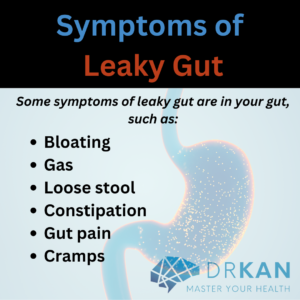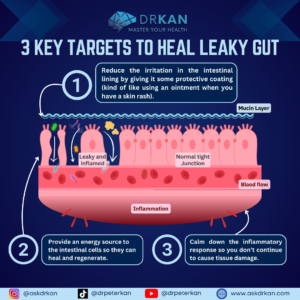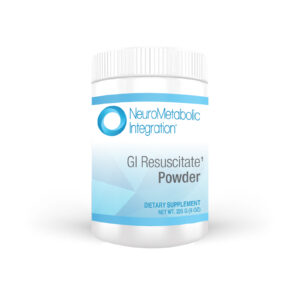3 Key Targets to Heal Leaky Gut

Are you ready to say farewell to brain fog? Check out my latest guide to healing leaky gut! In this article, you’ll discover how to stack powerful nutrients and herbs to seal and heal your gut in 3 target areas! Ready to unlock your gut-brain connection? Dive in now!
Leaky gut is a state where your intestinal lining has become too permeable.
Normally, some degree of leaky gut is actually normal, because it allows your immune system to sample what is going on inside the intestinal lumen and look for pathogens.
However, sometimes the intestinal lining becomes too permeable, and this is called intestinal hyperpermeability (but it’s commonly referred to as leaky gut). When the gut becomes too permeable, undigested food particles and microbial content can leak and spill into your bloodstream, causing your immune system to attack these substances like they are foreign invaders.
All of this causes a double whammy of malabsorption and inflammation! It’s also a precursor for developing autoimmune disease, or worsening an existing autoimmune disease.
Symptoms of Leaky Gut

Symptoms of leaky gut include GI problems, such as gas, bloating, loose stool, constipation, gut pain and cramps.

But it can also be outside the intestines, such as fatigue, brain fog, depression, aches and pains in the body, skin problems, and other seemingly unrelated symptoms, such as sensitivity to multiple chemicals like scents and perfumes, or sensitivity to multiple foods.
Structure of a Healthy Gut
To heal a leaky gut, first it’s important to understand the normal structures of the gut lining you are attempting to heal.
The Job Epithelial Cells in Healing Leaky Gut
Normally, the intestinal lining is made up of epithelial cells that are literally one cell layer thick. Think of it like Saran Wrap that covers your intestinal tract. This lining protects you by keeping undigested food and microbes inside the gut until you eliminate them through bowel movement. Because there is always food that moves through the GI tract, the epithelial lining sheds and gets replaced about once every 3 days, and is one of the fastest turnover cells in the body.
The intestinal cells secrete a mucin layer which creates some separation between the pathogens and the intestinal lining. The mucin layer also provides a place for the beneficial bacteria to colonize and lubrication to help with the passage of food through the GI tract.
The epithelial cells connect to each other and form tight junctions. The intestinal tract’s job is not only the absorption of nutrients, but also serves an important immune function to detect any pathogens that you may have ingested. For this reason, the intestinal lining is full of white blood cells and lymphoid tissue. In fact, 70-80% of your immune system resides in the gut.
How Your Immune System Interacts with Leaky Gut
Your gut lining is also an inflammation factory. This is because inflammation is how your immune system reacts to and gets rid of pathogens and cellular debris. If your gut is bombarded with pathogens, processed foods, alcohol, high blood sugar, stress, or other triggers of inflammation such as concussion, this will lead to chronic inflammation. And chronic inflammation causes leaky gut, which leads to more inflammation. Then you have a vicious cycle that can lead to chronic disease.
Often the symptoms of leaky gut can seem random and come and go. You may be able to tolerate a food one day, but react to the same food on another day. This can be really confusing, both for you and your doctor, because you can get random symptoms that are hard to pin down. Also, sometimes your doctor ends up just treating symptoms and chasing tails instead of correcting the root cause.
3 Key Targets to Heal Leaky Gut

So now you understand leaky gut better, there are 3 key areas to target when it comes to healing leaky gut.
- First is to reduce the irritation in the intestinal lining by giving it some protective coating, kind of like using an ointment when you have a skin rash.
- Second, you want to provide an energy source to the intestinal cells so they can heal and regenerate themselves.
- Third, you want to calm down the inflammatory response so you don’t continue to cause tissue damage.
Nutrients to Heal a Leaky Gut
Now there are specific nutrients that can help each of these targeted areas to support leaky gut. Each of these nutrients are powerful on their own. When they are combined, you get a synergistic effect that is more powerful than the individual part.
Zinc Carnosine for Leaky Gut
Zinc carnosine has been shown to have impressive mucosal-protective and anti-ulcerative properties, including combating H. pylori, protecting the intestinal lining and supporting the integrity of tight junctions against intestinal mucosal damage caused by intense exercise or certain anti-inflammatory medications. (1, 2)
Zinc carnosine helps to neutralize the damaging effects of the NSAID indomethacin on causing gut permeability in healthy human subjects when compared to placebo.(3)
For individuals dealing with the effects of prolonged aspirin use, clinical trials have shown a noticeable improvement in patients taking zinc carnosine within four weeks, with a reduction in mucosal lesions and ulcers, as verified by capsule endoscopy.(4)
The mechanism behind zinc carnosine’s effectiveness is attributed to its unique composition, where zinc is chelated with L-carnosine. This specific formulation ensures that the compound remains stable and bioavailable in the gastric environment, targeting and adhering to the affected areas for localized healing. Upon reaching these sites, the zinc and L-carnosine dissociate to exert their therapeutic effects on the tissue.(5,6)
L-Glutamine for Leaky Gut
Glutamine plays a pivotal role in maintaining the health of intestinal cells, serving as their principal source of energy and supporting the repair and upkeep of rapidly renewing tissues such as the intestinal lining’s epithelial cells.
A deficiency in glutamine can lead to significant deterioration of the intestines. Factors such as trauma, infections, burns, and various stress-induced and catabolic conditions amplify the body’s demand for glutamine, categorizing it as a conditionally essential amino acid under these circumstances. (7)
Research highlights the benefits of supplemental L-glutamine, noting its supportive effects on the immune system and the protective actions it provides for the gastrointestinal mucosa. (8,9)
Additionally, L-glutamine is recognized for its role in preventing the breakdown of muscle tissues, making it a popular supplement among bodybuilders.
Studies indicate that glutamine supplementation can mitigate the increase in intestinal permeability commonly induced by strenuous exercise, which is often associated with inflammation and gastrointestinal discomfort post-activity.(10)
Its function as a precursor for glutathione suggests that L-glutamine may also enhance the body’s antioxidant defenses.
Methylsulfonylmethane (MSM) and Quercetin
These substances are known for their anti-inflammatory properties, which may offer protection against leaky gut. These substances play a role in mitigating chronic inflammation, potentially safeguarding the integrity of the intestinal lining.
Quercetin is noted for its ability to stabilize intestinal mast cells, preventing excessive histamine release. Additionally, it contributes to tissue health through its antioxidant properties, further supporting intestinal well-being.(11)
Both human and animal research underscores MSM’s effectiveness in diminishing inflammation, bolstering the immune system, and exerting indirect antioxidant effects. This is achieved through the inhibition of NF-κB activity and a decrease in the expression of enzymes and cytokines that are pivotal in the generation of reactive oxygen species.(12)
Moreover, MSM supresses the expression of COX-2 and inducible nitric oxide synthase (iNOS), curbing the production of superoxide and nitric oxide free radicals, which are key players in oxidative stress.(12)
N-Acetyl Glucosamine
N-acetyl glucosamine (GlcNAc) plays a crucial role in providing structural support to the cells lining the intestines and helps modulate inflammation within mucosal cells.
It aids the body in synthesizing glycosaminoglycans (GAGs), which are essential for maintaining mucosal health and reducing intestinal permeability.
Research indicates that GlcNAc can inhibit the formation of biofilms by various E. coli pathogens, an issue commonly linked with dysbiosis in conditions like inflammatory bowel disease and celiac disease.(13)
In animal studies, GlcNAc helps to diminish the pro-inflammatory actions of NF-kB, TNF-alpha, and IL-6. Additionally, it has shown potential vaso-protective benefits during instances of acute vascular injury.(14)
Deglycyrrhized licorice root, Aloe Vera, Slippery Elm, Marshmallow, Chamomile, Okra, and Cat’s Claw
Each of these botanicals has a longstanding history in the management of gastrointestinal disorders. These herbs, known for their mucilaginous properties, are beneficial for supporting intestinal health.
They assist in coating and soothing the intestinal lining, aiding in the healing of ulcers and inflamed tissues, and help reduce intestinal cramping by providing a relaxing effect on the intestines. (15-18)
Mucin, a glycoprotein secreted by intestinal epithelial cells, plays a pivotal role in coating the intestinal lining. It is integral to the innate immune system, serving as a primary defense mechanism and facilitating colonization by beneficial intestinal microbes. (19)
Mucin’s contribution to a healthy mucosal layer is crucial in neutralizing intestinal antigens, thereby potentially mitigating inflammation and tissue damage arising from food allergies, intestinal infections, and dysbiosis. (20)
Additionally, mucin protects intestinal epithelial cells from physical or chemical injuries and acts as a lubricant, easing the passage of materials through the gastrointestinal tract.
Prune Powder and Citrus Pectin are known for their ability to support bowel regularity, offering a gentler alternative to the harsh effects of conventional herbal laxatives like senna. Prunes, rich in sorbitol and chlorogenic acid, are recognized for their efficacy in promoting healthy bowel function. (21,22)
My Favorite Method to Heal Leaky Gut
As you can see, there are many nutrients and herbs that can support the healing of your leaky gut. But when these nutrients are stacked to address the 3 specific targets in healing leaky gut, you get a more powerful and synergistic effect.
This is the reason why I use GI Resuscitate in my practice to heal the gut.
GI Resuscitate is formulated with all of the ingredients that are listed above in one convenient and great tasting powder. It can be mixed into any beverage or functional food powder.

Why GI Resuscitate Is My Favorite Product for Healing Leaky Gut
- Powdered form contains a delicious peach flavor and is sweetened with stevia
- Provides 1.5 grams of L-glutamine, 1 gram of citrus pectin, and 1 gram of N-acetyl-D-glucosamine per serving
- Contains a blend of botanicals designed to support gut health, including DGL, marshmallow, and cat’s claw
- Chelated form of zinc L-carnosine for optimal support of GI health
- Non-GMO ingredients
- Gluten-free, dairy-free, and soy-free
Benefits of Using GI Resuscitate for Leaky Gut
- Rejuvenates intestinal mucosal health
- Supports integrity of the small intestine for proper intestinal permeability
- Provides support for a healthy mucosa and a normal inflammatory response
- Promotes regularity and healthy bowel function
- Supports gut-associated immune function
How to Use GI Resuscitate
Mix 8 grams (approximately one scoop) in water or other liquid once per day.
Alternatively, you can mix ½ scoop twice per day.
In cases of severe leaky gut, you may use 1 scoop twice per day for 2-4 weeks, or as directed by your healthcare practitioner.
GI Resuscitate pairs perfectly with NeuroMetabolic Meal or NeuroMetabolic Paleo for a great tasting smoothie or protein shake. Use this to heal leaky gut and improve your energy and metabolism.
Add Fiber FX to add soluble and insoluble fiber to support gut microbiome, blood sugar, and bowel regularity.
You can find all of these products at shop.askdrkan.com
How Long to Use GI Resuscitate
How long do you want to have great gut health and no leaky gut?
You can use it on-going as part of a healthy lifestyle and gut health protocol.
Additionally, you can use it short term for 1-3 months for a jumpstart and quick recovery.
